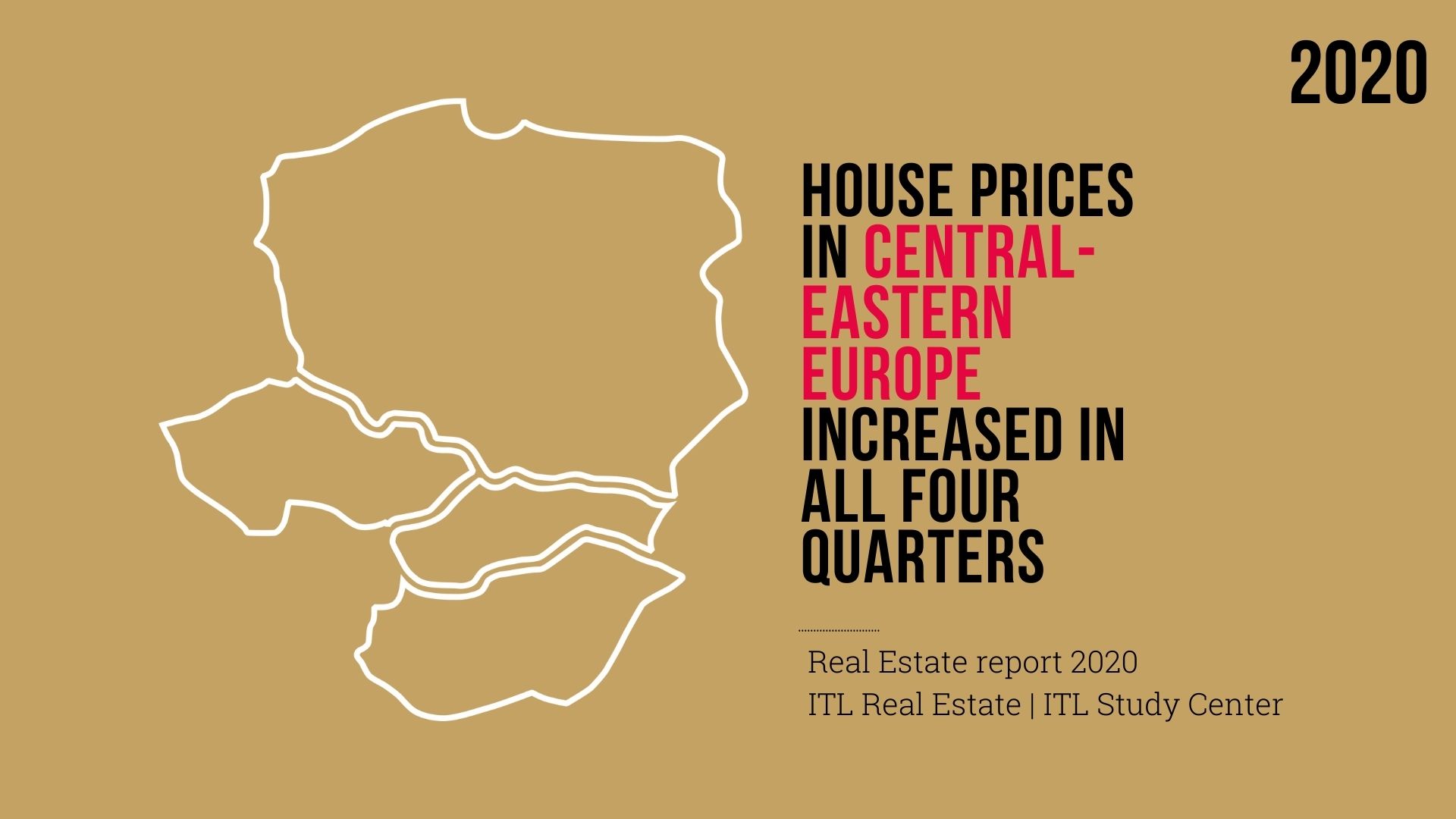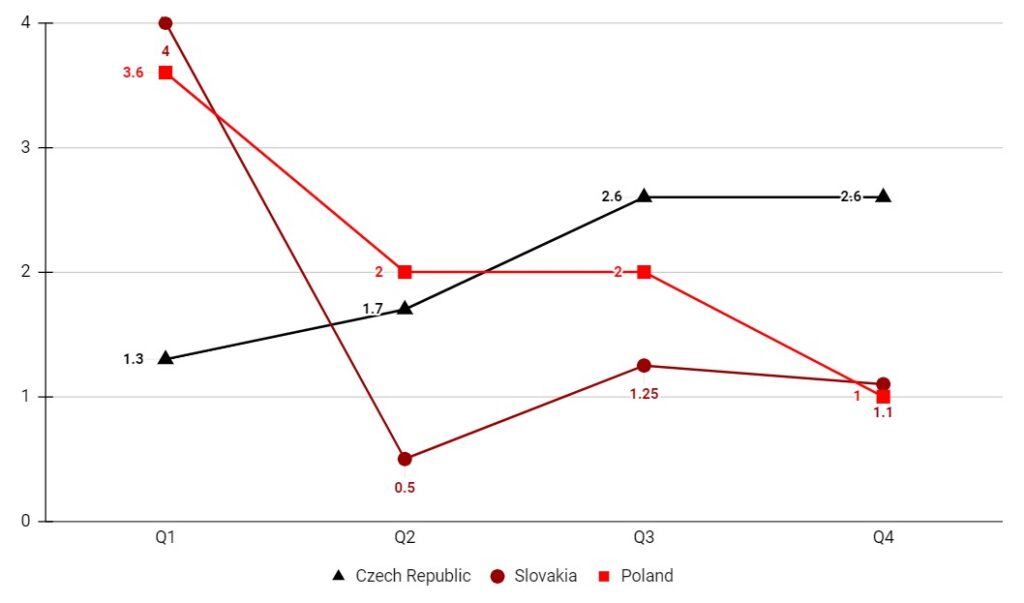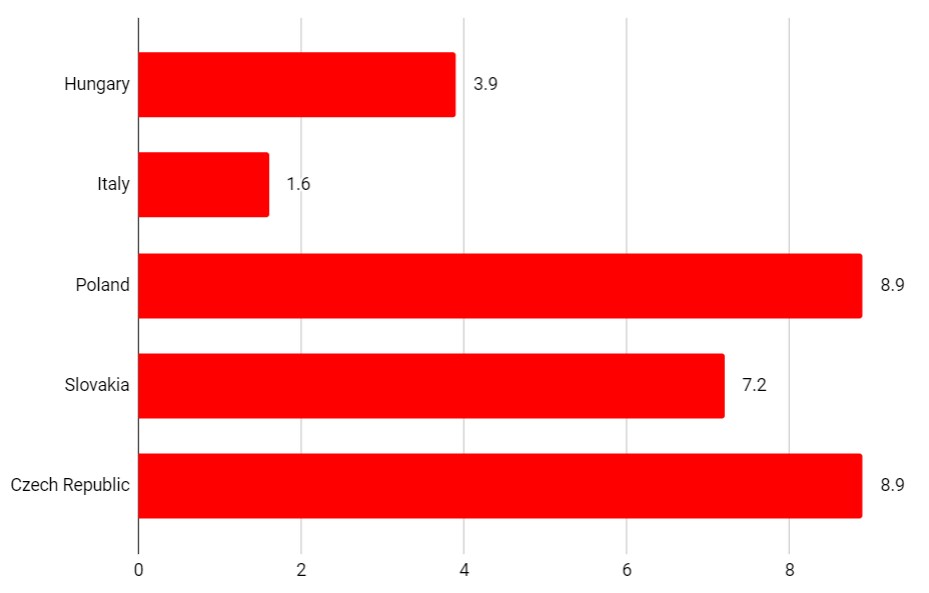
During 2020, in most of the Eurozone, house prices generally compared to 2019. However, a reduction occurred in at least one of the four quarters, which was inevitable due to the economic crisis triggered by the Coronavirus. Contrary to all expectations, in the member countries of the Visegrad Group (the Czech Republic, Slovakia, Hungary and Poland), house prices increased in all four quarters. The following table provides a summary:
Table 1– Positive percentage changes in the four quarters of 2020 in the Czech Republic, Slovakia, and Poland
| Q1 | Q2 | Q3 | Q4 | |
| Czech Republic | 1,8 | 1,7 | 2,6 | 2,6 |
| Slovakia | 4 | 0,5 | 1,5 | 1,1 |
| Poland | 3,6 | 2 | 2 | 2 |
The data from Eurostat and OECD allow us to establish immediately that the economic crisis of 2020 has not had a noticeable effect on Hungary’s neighbouring countries in terms of house prices. Inevitably there are differences in the variations, but in no case has there been an actual lowering of prices compared to the previous year.
As far as the Czech Republic is concerned, mortgages were among the few sectors that registered an increase. Investments in housing have always been considered safe and efficient. The first actual closure due to the pandemic only brought complete transactions that were already in progress, but the volume of these investments was such that prices rose compared to the same period in the previous year.
The value of housing transactions rose from 23.5 billion kroner in the first quarter of 2019 to 27.5 billion kroner in the first three months of 2020. There were no noticeable changes in the following quarters. During the summer, the housing market continued its ascent and the predictions of a slowdown for the second Covid wave were all wrong. Overall the growth in the number of homes purchased and the rise in prices resulted from the ever-increasing issuance of mortgages for real estate purposes with a total value of around 250 billion kroner.
This was particularly true for Prague, which alone accounts for over 60% of the Czech residential market. The various restrictions on the movement of people have certainly had an impact on foreign investors, whose weight was, however, already decreasing before the pandemic. On the other hand, the willingness of local families and businesses has increased, and, in line with what has happened elsewhere in Europe, they have reacted to the Coronavirus with a very prudent approach. Another important factor contributing to the increase in property purchases and sales and, therefore, to the rise in prices was the low value of mortgages, which made access easy even for those who did not have sufficient savings to cover the entire transaction.
Somewhat different factors drove the increase in house prices for Slovakia than in the Czech Republic. The trend is quite different as well. The growing number of home buyers caused a remarkable 4% increase in the first three months due to rising wages, increased demand and rental prices, rising land prices, and rising interest rates. In more precise terms, the Slovak economy underwent real economic growth in all sectors in the years before the development of the pandemic, and this led to an increase in the cost of living, which inevitably also affected the real estate market. The arrival of the pandemic, however, abruptly halted this growing trend. Although no negative values were registered in the quarters following the first, the residential prices’ growth rates were much lower than in the first quarter.
Also, in Poland, the development of housing prices had increasing values over 2019. Polish people indeed consider real estate investments to be safe. In addition, as in Slovakia, the economy was very positive in the years leading up to 2020, and therefore the negative impact of Covid was not very influential compared to many other European countries.
Chart 1 – Percentage differences in house prices in the four quarters of 2020, compared to 2019, in slovakia, czech republic and poland

What happened in the fourth quarter of 2020? A comparison with 2019
A comparison with the fourth quarter of the previous year and taking into account the countries under consideration shows the following results:
Table 2- Percentage variations obtained through a comparison of the visegrad group countries and italy with the fourth quarter of last year
| Czech Republic | 8,9 |
| Slovakia | 7,2 |
| Poland | 8,9 |
| Italy | 1,6 |
| Hungary | 3,9 |
Observing the data shown in the table above, we can see that the economic crisis caused by Covid has been more influential in Hungary and Italy. For the latter, the increase was almost nil. This result was a consequence of the fact that there was a meager percentage of property purchases in Italy in the year of the pandemic. The increase was very considerable in the Czech Republic, Slovakia, and Poland, also because in these countries, as already mentioned, there was never a negative price value. The following graph further highlights the very considerable differences between these countries:
Graph 5 – Percentage increases obtained through a comparison with the fourth quarter of the previous year




